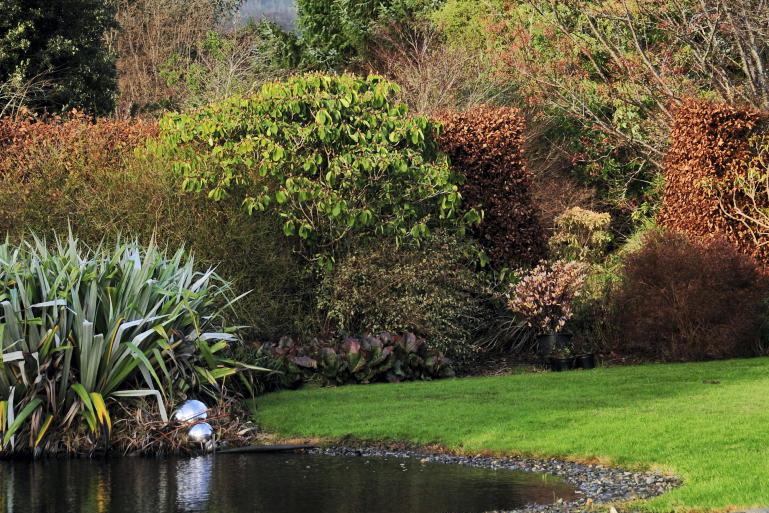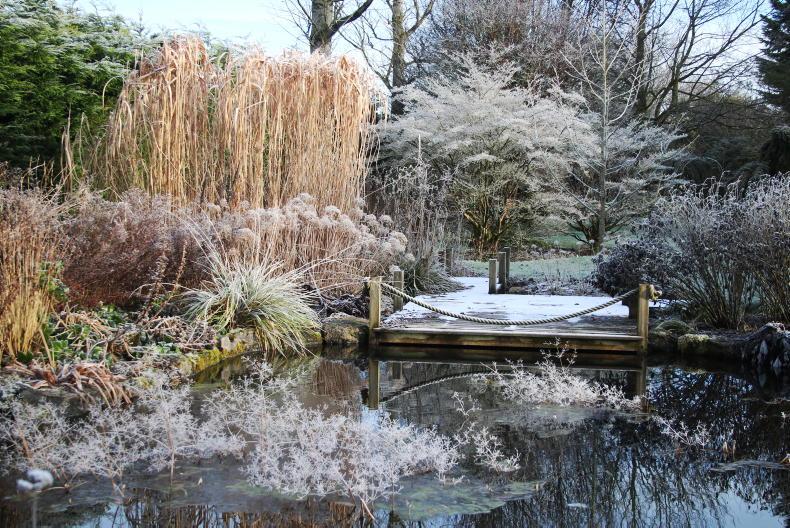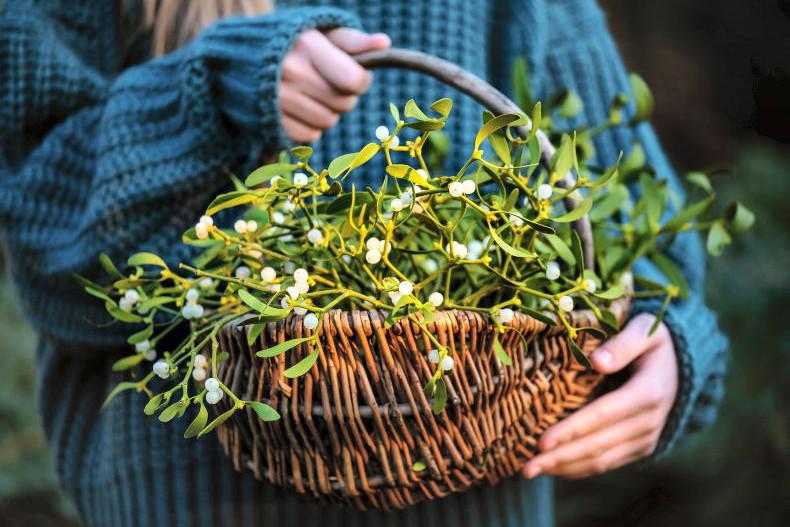The garden in winter can be very attractive, different to the rest of the year but no less charming. A good furnishing of plants is essential to provide the charms of winter: bare trunks, twigs and buds; dried flower heads, leaves and stems of herbaceous plants; greenery of evergreens; greenery of the lawn; flowers of winter-flowering plants, and withered leaves or moss on soil surface. The low light of the weak winter sunshine highlights these aspects and makes the most of them.
Bare trunks and branches can be clearly seen now, and it is surprising how they have grown, unnoticed, in girth since last year. Tree trunks and the stems of large shrubs have considerable decorative qualities of colour, texture and pattern. There are several tree species noted for their bark effects – maples, eucalyptus, mahogany bark, cherry and birch. Others such as willow and dogwood have brightly coloured twigs. But even less noticeable kinds can contribute much because of the structural pattern of the branches. Every kind of tree and bush is different and, in fact, each individual tree has a unique branch pattern. Most people appreciate these effects without being aware of them.
Plants with evergreen foliage keep the garden alive during winter and evergreens, mostly the broad-leaved kind, should be well represented in a garden for winter effect. If there is not a good proportion of evergreens, about one in four, the preponderance of deciduous trees can make the garden look very empty and forlorn. Some evergreens have yellow, variegated or purplish colour and, while these are useful, they should not be over-used.
While the foliar contribution of evergreen perennial flowers such as bergenia and lamb’s ear is appreciated, the effect of withered flower heads, stems and leaves is often overlooked. Most herbaceous plants can make some contribution, especially those which wither rather than rot. For instance, hosta and Peruvian lily rot away completely soon after they wither but the flower heads of sedum, the stems of phlox and campanula and the leaves of many grasses last for months before they rot and some of these do not rot until the summer.
Winter-flowering plants are few in number and are invaluable: witch hazel, fragrant viburnum, hellebores, winter-flowering cherries, sweet box, snowdrops, winter jasmine, daphnes and Algerian iris. Make sure to include some of these in key positions where they can be fully enjoyed. Many of these, such as daphnes, sweet box, witch hazel, viburnum and even snowdrops are among the best scented garden plants and this is a very enjoyable aspect of the winter garden.
The value of a good lawn is greatly underlined in winter. If the grass has been well cared for during the year — regularly mowed and occasionally fertilised — it will be looking green and smooth. If it has been poorly kept up, the lawn will be yellowish, brown or patchy and will not add much to the overall decorative effect. A good green lawn brightens the garden and compensates for bareness of trees and shrubs.

Angel wings
Botanical name: Senecio candicans is the botanical name for ‘angel wings.’ Senecio is the Latin name for ragwort, though it is very different from the ragwort of old pastures and motorway sidings. The word candicans means white, which it is.
Family: Senecio, or angel wings, is part of the large Daisy family, as can be observed by the shape of the daisy-type flowers. The plant closest to this Senecio is cinerea, which also has similar grey leaves, but in this case, they are much more divided by comparison with Senecio.

Angel wings
Angel wings is a relatively new plant in garden centres, only appearing in the last few years. Its widespread availability is an indicator of the level of interest that the plant has gleaned in a relatively short period of time. The large, undivided leaves are about 10 cm in length, and almost as broad. They form a long lasting, clump of silver-grey foliage that is evergreen year-round. Although it might get a bit tired -looking in winter when rainfall can be a bit too generous.
Native to coastal regions of Chile and Argentina, angel wings is a versatile plant, suitable for planting in the open ground or in containers. Its woolly white foliage is green underneath the white layer of plant hairs. Its colour is neutral and goes with every colour: blue, orange, yellow, lemon, lime, purple, red, white, pink and green. Although it will survive a mild winter, and did so last year, it does not like temperatures below -5 Celsius. It is a short-live perennial flower, grown for its foliage, which is remarkable, but it flowers very little, if ever, and probably needs a hotter summer climate.
Trees, Shrubs and Roses
If the soil is not too wet, it is a good time to plant trees and shrubs. Roses too can be planted and the bedding kinds and repeat-flowering climbers pruned. It is a good time to tidy up fallen branches and twigs under trees where bulbs will soon emerge.
Fruit, Vegetables and Herbs
The vegetable area can be tided, compost turned, and weeds controlled. Raspberry canes should be tied in to wires against the possibility of wind damage. Pruning of apples and pears can be carried out. Fruit trees and bushes can be planted.
Flowers
Messy old flower stems can be tidied away or chopped up and allowed lie and rot where they fall. It is possible to divide some kinds of perennials — clump-rooters that have died back completely below soil as it becomes difficult to find these plants.
Lawn
Take the chance to mow the lawn if there is a dry spell. Moss can be controlled with sulphate of iron traditionally and other products, and it is better to do it now than to wait until spring when grass will have been out-competed by strong moss growth.
Greenhouse and House plants
Ventilate the greenhouse during good weather to prevent rotting of plants. Do not overwater. Prune a grapevine during this dormant spell. Watch for pests such as greenflies on fuchsias and other greenhouse plants, and scale insects on camellia.
Read more
Gardening: festive foliage, foraging and bird-watching
Putting her heart and soul in the soil
The garden in winter can be very attractive, different to the rest of the year but no less charming. A good furnishing of plants is essential to provide the charms of winter: bare trunks, twigs and buds; dried flower heads, leaves and stems of herbaceous plants; greenery of evergreens; greenery of the lawn; flowers of winter-flowering plants, and withered leaves or moss on soil surface. The low light of the weak winter sunshine highlights these aspects and makes the most of them.
Bare trunks and branches can be clearly seen now, and it is surprising how they have grown, unnoticed, in girth since last year. Tree trunks and the stems of large shrubs have considerable decorative qualities of colour, texture and pattern. There are several tree species noted for their bark effects – maples, eucalyptus, mahogany bark, cherry and birch. Others such as willow and dogwood have brightly coloured twigs. But even less noticeable kinds can contribute much because of the structural pattern of the branches. Every kind of tree and bush is different and, in fact, each individual tree has a unique branch pattern. Most people appreciate these effects without being aware of them.
Plants with evergreen foliage keep the garden alive during winter and evergreens, mostly the broad-leaved kind, should be well represented in a garden for winter effect. If there is not a good proportion of evergreens, about one in four, the preponderance of deciduous trees can make the garden look very empty and forlorn. Some evergreens have yellow, variegated or purplish colour and, while these are useful, they should not be over-used.
While the foliar contribution of evergreen perennial flowers such as bergenia and lamb’s ear is appreciated, the effect of withered flower heads, stems and leaves is often overlooked. Most herbaceous plants can make some contribution, especially those which wither rather than rot. For instance, hosta and Peruvian lily rot away completely soon after they wither but the flower heads of sedum, the stems of phlox and campanula and the leaves of many grasses last for months before they rot and some of these do not rot until the summer.
Winter-flowering plants are few in number and are invaluable: witch hazel, fragrant viburnum, hellebores, winter-flowering cherries, sweet box, snowdrops, winter jasmine, daphnes and Algerian iris. Make sure to include some of these in key positions where they can be fully enjoyed. Many of these, such as daphnes, sweet box, witch hazel, viburnum and even snowdrops are among the best scented garden plants and this is a very enjoyable aspect of the winter garden.
The value of a good lawn is greatly underlined in winter. If the grass has been well cared for during the year — regularly mowed and occasionally fertilised — it will be looking green and smooth. If it has been poorly kept up, the lawn will be yellowish, brown or patchy and will not add much to the overall decorative effect. A good green lawn brightens the garden and compensates for bareness of trees and shrubs.

Angel wings
Botanical name: Senecio candicans is the botanical name for ‘angel wings.’ Senecio is the Latin name for ragwort, though it is very different from the ragwort of old pastures and motorway sidings. The word candicans means white, which it is.
Family: Senecio, or angel wings, is part of the large Daisy family, as can be observed by the shape of the daisy-type flowers. The plant closest to this Senecio is cinerea, which also has similar grey leaves, but in this case, they are much more divided by comparison with Senecio.

Angel wings
Angel wings is a relatively new plant in garden centres, only appearing in the last few years. Its widespread availability is an indicator of the level of interest that the plant has gleaned in a relatively short period of time. The large, undivided leaves are about 10 cm in length, and almost as broad. They form a long lasting, clump of silver-grey foliage that is evergreen year-round. Although it might get a bit tired -looking in winter when rainfall can be a bit too generous.
Native to coastal regions of Chile and Argentina, angel wings is a versatile plant, suitable for planting in the open ground or in containers. Its woolly white foliage is green underneath the white layer of plant hairs. Its colour is neutral and goes with every colour: blue, orange, yellow, lemon, lime, purple, red, white, pink and green. Although it will survive a mild winter, and did so last year, it does not like temperatures below -5 Celsius. It is a short-live perennial flower, grown for its foliage, which is remarkable, but it flowers very little, if ever, and probably needs a hotter summer climate.
Trees, Shrubs and Roses
If the soil is not too wet, it is a good time to plant trees and shrubs. Roses too can be planted and the bedding kinds and repeat-flowering climbers pruned. It is a good time to tidy up fallen branches and twigs under trees where bulbs will soon emerge.
Fruit, Vegetables and Herbs
The vegetable area can be tided, compost turned, and weeds controlled. Raspberry canes should be tied in to wires against the possibility of wind damage. Pruning of apples and pears can be carried out. Fruit trees and bushes can be planted.
Flowers
Messy old flower stems can be tidied away or chopped up and allowed lie and rot where they fall. It is possible to divide some kinds of perennials — clump-rooters that have died back completely below soil as it becomes difficult to find these plants.
Lawn
Take the chance to mow the lawn if there is a dry spell. Moss can be controlled with sulphate of iron traditionally and other products, and it is better to do it now than to wait until spring when grass will have been out-competed by strong moss growth.
Greenhouse and House plants
Ventilate the greenhouse during good weather to prevent rotting of plants. Do not overwater. Prune a grapevine during this dormant spell. Watch for pests such as greenflies on fuchsias and other greenhouse plants, and scale insects on camellia.
Read more
Gardening: festive foliage, foraging and bird-watching
Putting her heart and soul in the soil











SHARING OPTIONS